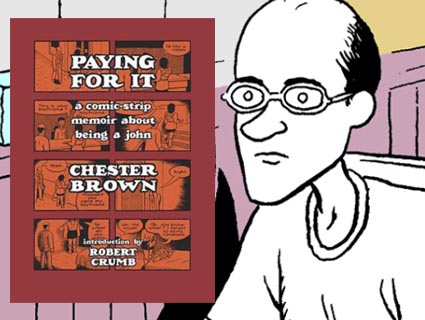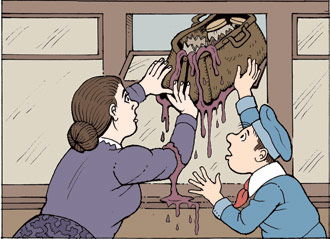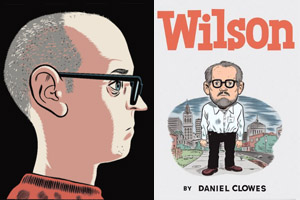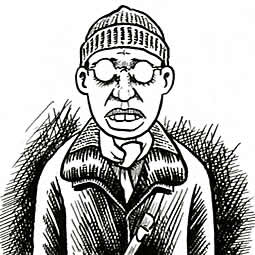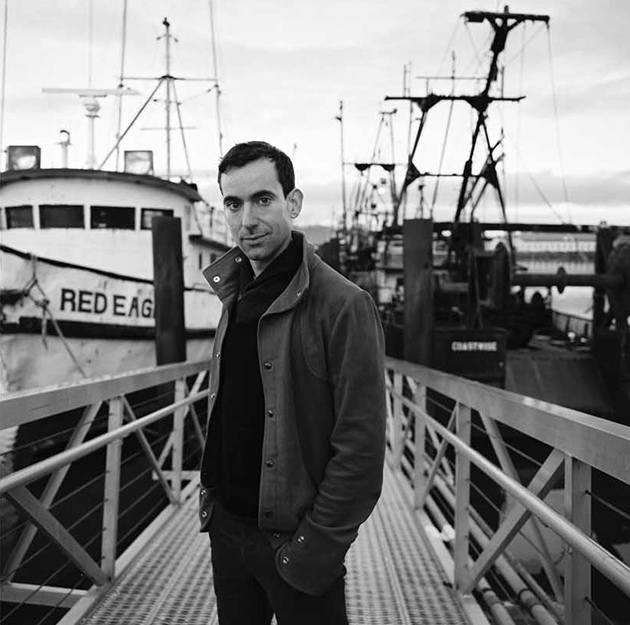
Craig Thompson grew up in rural Wisconsin, where his access to media was strictly controlled by his fundamentalist Christian parents. But comics flew under their radar, so that’s where Thompson, then a socially awkward nerdling, ended up gravitating. His 1999 debut, Good-bye, Chunky Rice won a Harvey award and was nominated for an Ignatz—named for the beloved Krazy Kat character. He followed up with the mini-comics Bible Doodles and Doot Doot Garden, but it was Thompson’s 2003 release of Blankets, an autobiographical coming-of-age saga that earned him a shower of awards and cemented his place in the comic pantheon—even as it led to a family rift. Maus creator Art Speigelman sent him a laudatory letter, and Time dubbed Blankets the year’s best graphic novel, while Paste magazine would later name it the decade’s best.
At a staggering 672 pages, Habibi, Thompson’s new book out this week, is a richly rendered love story set in a fictional Middle-East that’s simultaneously modern and medieval. The author weaves the adventures of his slave-child protagonists with tales from the Bible and the Koran, numerology, and themes of imperial debauchery and environmental degradation. “I wanted to do a book that was bigger than myself, either something sort of fantastical and epic like Lord of the Rings or something with political relevance, like Joe Sacco‘s documentary work,“ says Thompson, who is now 36 and living in Portland, Oregon. “So I think those two modes met somewhere in the middle: a social-political fairy tale.“
Mother Jones: I grew up in Madison, but never got as far north as Marathon. What’s it like there?
Craig Thompson: The town, when I was growing up, was population 1,200. There’s a cheese factory there, and that’s sort of the center. The elementary school and the high school are on pretty much the same block, and pretty much your entire life is there.
MJ: Did your parents work in the factory?
CT: They didn’t, actually. My dad was a plumber, and my mom was on and off again, either a stay-at-home mom or working with the disabled as a visiting-nurse assistant. We lived a 10-minute drive outside of town, in the country, on a highway.
MJ: You were cartooning early on, right?
CT: Yeah. I grew up in a very working-class family and also a very fundamentalist Christian family. So, we didn’t have access to the arts in the house in any form other than the Sunday funnies.
MJ: Were the arts frowned upon by your parents?
CT: I think that’s one of the reasons I imprinted myself on the medium: They did censor all the media in the house. All the movies they’d watch first, and the television shows—it was very strict. Only Christian music was allowed, no secular music. But comic books were below the radar because they were children’s entertainment, you know? They didn’t even consider them. So I think that’s why my brother and I were obsessed with comics; that was like our edgiest form of entertainment.
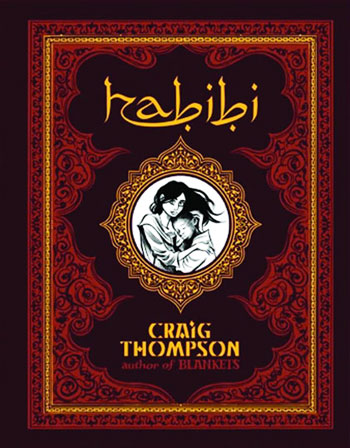
“I don’t think my parents will like Habibi.”
MJ: What comics were you most into?
CT: We were really obsessed with Black and White comics, which were sort of part of this ’80s, Teenage Mutant Ninja Turtles part of the industry. But it was indie creators, like self-publishing. They were generally escapist fantasy fun, but they were still more edgy and more, like, auteur-style than corporate superhero comics. We loved the DIY ethic behind it—that this is just one creator, one person, writing and drawing these and publishing them.
MJ: You must be familiar with Chick Tracts, those evangelical Christian morality comics?
CT: Yes, although I don’t think I had access to those until I moved to Milwaukee. I was already 19 or 20 then. Jack Chick’s sort of political and religious stance matches my parents’—including that sort of strange, the Pope is the Antichrist, and those sorts of things.
MJ: Was your family part of an organized church?
CT: It was an evangelical church we saw evolve from a couple families meeting in a living room at one person’s house. And then there was a pastor. He was kind of a hippie pastor. These are all sort of small-town people but kind of growing out of the back-to-nature sort of Jesus-freak movement of the ’60s and ’70s. We’d sit in people’s living rooms and sing Jesus songs that our pastor made up. And then at a certain point the church had access to a storefront that I think also hosted other churches, and they just had couch cushions on the ground. And then we rented out the City Hall, until it burned down. That was a cool space. And then we rented time at a Presbyterian church, so after their service we would have service. Finally, when I was in high school, the church bought its own building, or had it constructed, and then the political dynamics changed a lot; it became more conservative and half of the people left.
MJ: More conservative in what sense?
CT: In every sense. The new people were older and it became more of a fire-and-brimstone sort of church. I felt pretty attached to the pastor I grew up with—he literally was a carpenter by trade and had long hair and a beard and made homemade songs on his acoustic guitar. It was, you know, a hippy-dippy version of Christianity. And then he left; I think he was booted out by the more conservative people that started to pour in.
MJ: Do you still consider yourself a Christian?
CT: No, I don’t consider myself a Christian at all.
MJ: Was there something in the church’s teachings that turned you off?
CT: It was slow and instant at the same time. The slow part happened all throughout my high school years, where I was really obsessed with Jesus and his teachings, but really disenchanted with the church and its dogma. I was pretty feminist back then—a little scrawny vegetarian Christian feminist boy. [Laughs.] So I clashed with a lot of the teachings, and a lot of the Bible, actually. But I loved Jesus and his ethics. That was sort of the career path I wanted to follow, too: just to live like Jesus, not have any belongings, not have any job, not pay any rent. It was very hippie.
MJ: That attitude could come in handy for a struggling cartoonist.
CT: Yeah, definitely. I think there is some overlap in terms of artistic desires and Christian desires.
MJ: So have you also said goodbye to Jesus, or are you still down with him?
CT: I’m still down with Jesus. I like to think of him mostly as a social revolutionary who mixed with bad crowds and hated the rich. [Laughs.]
MJ: So was there a big rift with your parents after you split from the church?
CT: Blankets was the vehicle with which I came out to my parents about not being a Christian, so we never really had that conversation. Typical sort of northern Midwest, stoic personalities: There isn’t a lot of conversation or communication in our dynamic, so it just never came up. They never ask things about my life. They were really concerned about me going to church and stuff like that, but they never pressed for further details about Blankets, which is a lot about my falling from the faith.
MJ: But they read it?
CT: They did read it. Yeah, I sent it to them. And it caused, at least for a couple of years, a lot of tension. But things are feeling better now.
MJ: Have they commented on your career?
CT: They used to be very upset by it and say that my work was satanic, even. They used that term. And so, they were really troubled by the message, they said it was the devil’s message in my work. And when they had suggestions of how I could use my talent, they would bring up like, VeggieTales, those Christian animated vegetables.
MJ: Have you sent Habibi to your parents?
CT: No. I’ll definitely send it to them as soon I have the official, printed version.
MJ: What do you think they’ll think of that?
CT: I don’t think they’ll like it. But at the same time, I don’t think it could be worse than Blankets, because Blankets was about our family; it was about Christianity, it was very personal. I just feel like, you know, it can’t get worse—not with my family, I don’t think.
MJ: So this book is coming out the day before your 36th birthday. That’s quite a present!
CT: Yeah, it is. You’ve read the book, so you know about all the numerological concerns. And I like the numerology there, since 36 is nine, and the book is kind of based on that nine-panel grid.
MJ: Yeah, I loved how you organize the book. But let’s talk about the number seven. I can totally see why it’s been seven years since your last book. Habibi is an epic: 672 pages with tons of detail and all this insane calligraphy. Did you have a clue what you were getting into?
CT: Not at all. I thought I’d spend two years on a book, and I thought I would do it really quickly.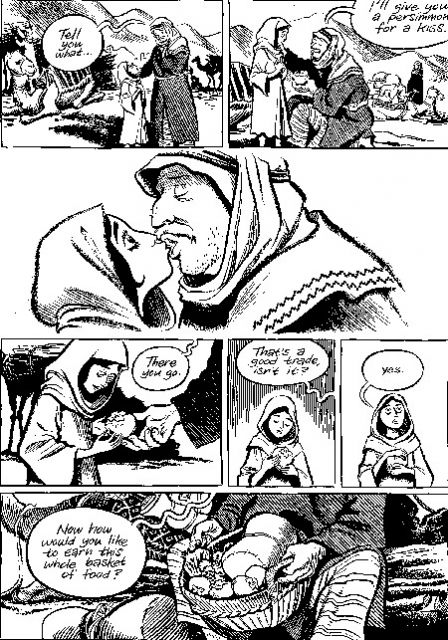
MJ: How long did it actually take, from idea to completion?
CT: It was six years solid of work.
MJ: Have your other books sold well enough that you could focus on this, or did you have to freelance on the side?
CT: Blankets has sold pretty well. Not enough to make a sole living, but with foreign editions and the advance on Habibi, I was able to swing it. The key was having an advance, which I’d never had before.
MJ: The first time I read it, I was just sort of into the story. The second time I was really noticing all the minutiae and I was going, “Holy cow, how long this must have taken!“ The panels are beautifully rendered.
CT: That should be the strength and pleasure of comics, that you can read it through quickly the first time but then go back and savor the images.
MJ: The cover resembles a Koran, which is fitting. How’d you learn the Koran?
CT: The Koran I didn’t start reading until I was researching for Habibi. And I like it a lot more than the Bible, although I don’t think you can’t substitute—because I feel like the Koran depends on you having a knowledge of biblical stories already. You can tell that the early Muslims already knew those texts. And their take on those stories is so much more poetic and mysterious.
MJ: You also indicate in Habibi that the two books diverge on key details, like which one of his sons Abraham tried to sacrifice to God.
CT: Yeah, there are various divergences. But all Muslims believe it was Ishmael and all Christians believe it was Isaac. It’s important to both faiths. I don’t really understand the difference. Well, I do, but I guess it’s strange that both sides are so adamant that it’s this son.
MJ: Yeah, and whereas Ishmael went willingly to the altar, Isaac had to be tricked.
CT: That point I think is really interesting. Those subtle variations; there’s so much to mine from them.
MJ: Regarding the calligraphy, did you study Arabic, or just learn enough to do the book?
CT: The latter. I learned the alphabet, the 28 letters, and paid particular attention to those nine letters that make up the chapters of the book. And it got to the point where I find pleasure in recognizing Arabic words because I know the letters. But no, I never learned to write or speak it. There’s a saying that Arabic calligraphy is music for the eyes, which is my attitude toward comics. It’s so much about timing and rhythm. 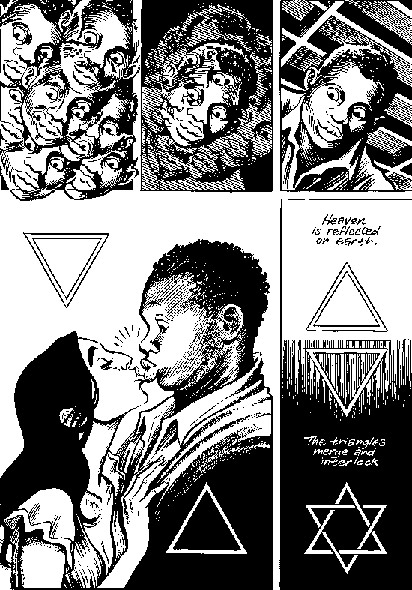
MJ: Habibi is a great example of nonlinear storytelling, all these little fragments, meanderings, dreams, tangents ultimately come together to form a complete picture. Is that something you worked hard on, or is it just the way you go about telling stories?
CT: Both, I think. It feels very natural to write that way in comics. It’s easier to make those leaps in comics than in most other mediums—in a film, if there’s a big jump, it can be confusing, but with comics you can just look at the previous page or previous panel and have somewhere to place your footing. My first draft of Habibi was much more linear and it was falling very flat, until I took a cue from 1001 Nights of kind of breaking everything apart and putting it back together in a nonlinear form.
MJ: 1001 Nights. Elaborate.
CT: Just the idea of folding one story in on another story, and you never knew where you began. And Scheherazade—I think it’s potent for any artist, this idea of storytelling for survival.
MJ: Yeah, you used that notion in your own story.
CT: I used all the tropes, like the scatological humor; even that comes from 1001 Nights. And a lot of the bawdy sexual humor is all in there too.
MJ: Now I’m going to have to go back and read it!
CT: You should. It’s totally scandalous and amazing and vulgar and obscene and surprising. You think of it as an old-fashioned work of literature. And then you read it and you’re like, “This is fucked up and completely crazy!“
MJ: That was the ancient entertainment. The fairy tales we have now have all been sanitized from the originals, but the originals are full of incest and murder and crazy shit.
CT: The Bible is too! It’s funny how we forget how daring those things are compared to modern-day entertainment.
MJ: Okay, so, numbers and patterns also play a huge role in Habibi. How did you get obsessed with that?
CT: Um, boy, I think it might be something natural about the cartoonist mind, when you become very neurotic about those kinds of things.
MJ: The pattern-making and numerology and symbolism: Is that in the Koran or did you make it up?
CT: It’s a combination. The birthplace of mathematics is in Arabic culture, and so I wanted to pay tribute to that. And as much as I was inspired by Arabic calligraphy, I was inspired by geometric design. I’m always struggling with panels in comics—why does it have to be just a box all the time? So I started thinking, what if I had chapters based on different geometric shapes, but also page compositions and panels based on shapes other than the standard square? And then it just spiraled off and became more obsessive. But it’s easy to became obsessive once you start studying geometric design—it’s really psychedelic and mind blowing to look at that stuff and think of the construction.
MJ: Your fictional Middle-Eastern realm has everything from slave markets and harems to junk heaps containing modern cars—although we don’t see much else by way of technology. You also have these recurring themes of environmental degradation, and imperial decadence alongside abject poverty. Do you see your setting as past or future or present day?
CT: All of those things, but probably most of all present day. It’s all infused with a sort of imperialist guilt, in a sense of being from this world power and then traveling to more-developing nations and seeing the old world rubbing up alongside the modern world, and seeing how our culture feeds off these other cultures. How all the wealth in our culture is created by the poverty in other countries.
MJ: So we’re the fictional kingdom of Wanatolia and the developing world is your village of outcasts?
CT: Yes. Some of it is just fueled from my own experience going to places like Morocco or Vietnam where people’s lives do feel like they’re from another time centuries ago, but at the same time there’s cars and televisions and all that stuff—and plenty of garbage and litter and pollution. I didn’t want to make it too modern. I didn’t want to have any guns or televisions in the book. So I got to pick and choose what I wanted. It’s a fairy-tale world with modern things, cars, and there’s plumbing and whatnot. But I’m not having people sitting around watching TV sets in the slums. Which would be closer to reality.
MJ: Have you traveled to the Middle East?
CT: No. It’s ironic I didn’t do more travel research. But I once I started drawing the book it became such a commitment. And also, from the beginning, it didn’t take place in any specific location or time.
MJ: You did do other research, though, like reading the Hadiths.
CT: Yeah, those are the reported sayings of the Prophet. Some of them are held very sacred; some of them are very questionable. The only prohibition from image-making comes from the Hadiths. There’s nothing in the Koran that says you can’t make images.
MJ: I notice you veiled your Muhammad.
CT: Yeah, and that was borrowing from Persian miniatures: That’s how the prophet is always depicted, and I like that idea. I have a couple of Muslim friends who were much more offended by how I presented other prophets, because every prophet is sacred in Islam. Which is a sort of a jarring thought for Christians, because they could care less. You can make fun of Noah or Abraham or anyone. Christians don’t have the same sort of sacred prophets.
MJ: So who among your artist peers do you most idolize?
CT: Joe Sacco above all others. And Joe’s a friend, a Portland-based cartoonist. But I think he’s the most important cartoonist in America. I don’t know if I have the talent or intellect to do the stuff he does. He’s a much more educated man than I. He’s definitely an inspiration.
MJ: I gather, like many cartoonists, that you felt very socially awkward as a kid. Was there a point where you realized, hey, wait, being able to do this stuff kind of makes me the cool guy.
CT: [Laughs.] It happened somewhere in high school. When I was little, I was definitely the mercilessly beat-up little nerd kid. By the time I was in high school, I was one of those punkish skateboard kids and wasn’t interested in comics very much. But I was reintroduced to the medium by people I found very cool, like other punkish skateboarder types. And then it kind of overlapped with my disillusionment with what I would do for a career—again, the DIY ethic. I was really interested in animation in high school, but had no idea about how a little working-class kid could get to a fancy art school and learn to be in the animation business. Plus, I recognized that you end up being a cog in the machine, designing and animating soap bubbles for a car commercial or something. I realized there wasn’t a lot of opportunity to have a unique artistic vision in animation. And that’s around the same time I rediscovered comics and was like, oh, one person can do it all—do the character designs and create the backgrounds and write the story.
MJ: You kind of have to isolate yourself, too.
CT: I definitely have that introverted side where I don’t mind being alone for eight hours doing my work. After that I don’t want to be alone.
MJ: Do you have a disciplined work schedule?
CT: I’m from the working-class Midwest: 9 to 6, that’s about my work day. I used to work much more than that, but I really wore myself down, and now I maintain this very boring sort of work day, which keeps me much healthier. I have a friend who’s a painter who calls painting “mowing the lawn,“ and I think it’s similar with most art; it’s like punching the clock and doing the work.
MJ: Flashes of inspiration mixed with vast amounts of tedium.
CT: There something natural about that for a cartoonist, the slowness of things, wanting to resist the fast pace of modern pop culture. Which is ironic since cartoons were born out of fast-paced pop culture; they were something that would be produced in a week and thrown on newsstands. But now with the graphic novel, it’s like the opposite—it’s resisting all the internet culture.
MJ: Do you personally resist that stuff? You do have your blog.
CT: I started that when I realized I’d been away from the scene for so long I was losing contact with my fan base. It’s nice to have that as a little forum. But I only update that once or twice a month. So no, I’m not a social-networking person. My publicist started a Facebook page for me recently. But that’s the closest I’ve come.
MJ: Are your fans obsessive?
CT: Some of them, yeah.
MJ: Tell me a story.
CT: I haven’t necessarily had any creepy stalker experiences. I didn’t have many fans before, so whenever I would meet a fan I could almost start a friendship with them. And then by the time Blankets exploded onto the scene, I had to start learning how to draw boundaries. I’d reply to one piece of fan mail and it’d open up a dialogue that I really didn’t have time for. But the coolest thing about my fans, at least previously, is that people connect with my work on such an emotional level. Sometimes at a bookstore signing, people will come up to me and tell a personal story and just start crying on the spot. I don’t mind. I mean, I’m blown away and intimidated by it, but also very moved by it, too.

